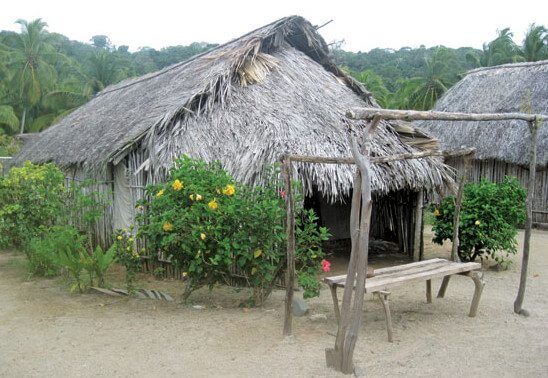
Every year, more cruisers leave the comfortable Eastern Caribbean and head west. When waiting for the right weather windows, especially off the Colombian coast, the sail to the Western Caribbean is a breeze with plenty of interesting stops along the way. Once cruisers reach the other side of the Caribbean Sea, they at least spend a few weeks in the marvelous San Blas Islands, or Kuna Yala – as the region is called locally – before transiting the Panama Canal or continuing further north.
The San Blas region has become quite popular in recent years – who wouldn’t want to sit in idyllic anchorages, surrounded by picturesque palm fringed beaches, while inviting coral reefs are only a swim away? But once you arrive, it is not obvious how you deal with certain parts of the cruising lifestyle, particularly during longer stays. While visiting the unique indigenous Kuna villages, you are courteous, friendly and reserved, but when can you snap a picture?
Here are some practical tips about life in the San Blas Islands for a boating visitor.
1: Check-in
Checking into Panama and the San Blas Islands is easier, cheaper ($0.50 for two copies), and more relaxed in Portobelo than in El Porvenir, where extra fees are charged. There is no need to head there straight away, but don’t overstay your welcome … For the $193 cruising permit, valid for a year, a bus ride into Colon and a visit to the Port Authority is required.
2: Taking Pictures
Kuna women are colorful, children are smiling and playful, thatched roofed huts are very picturesque and ulus (dugout canoes), with or without sail, are eye catching. In the more traditional eastern part of the archipelago, adults and sometimes even kids don’t like their picture taken, but photographing other parts of the village is accepted. Make sure you visit the sahila (chief) in the congreso (biggest hut) to introduce yourself before you start strolling around, and leave before dark. In the busier western part, expect to pay $1 per photograph of adults and always ask permission first.
3: Provisioning
Stock up before you arrive, especially on alcohol, butter and non-poultry. Most villages offer tiny Kuna breads, eggs, canned food and flour. Fresh produce and chicken are available in Nargana (Rio Diablo) and Wichubhuala. A well-stocked vegetable boat does its rounds in the more popular anchorages and fishermen will occasionally come by with fresh fish, crabs or lobster. Local entrepreneurs might swing by with eggs, beer, milk or wine. The islands offer thousands of coconuts, high above or just lying about; don’t take them, no matter how tempting … This is Kuna rule #1!
4: Gasoline, Diesel and Water
All of these necessities are available in the San Blas—if you know where to look—and Nargana is the place to start. Gas and diesel can be bought off a local man (with a decent dinghy dock) on the way to the municipal dock/bridge. There are three ways to obtain fresh water: Collect rainwater; take the dinghy up the Diablo River for three miles and fill jerry cans behind the engine-free barrier or stop in Rio Azucar where for $10 you can buy as much water as you want by filling jerry cans or docking the big boat (extra $5).
5: Laundry
Go up the Rio Diablo and join the local families doing laundry by hand, leave your dirty clothes with the laundry lady in Nargana or collect well water for the job.
6: Garbage
Garbage procedures are comparable to long voyages: Recycle as much as you can. Food scraps go overboard (at night), aluminum cans are welcomed by visiting Kunas, who sell them to the Colombian trading boats, glass is smashed and cans are opened at either end; both are sunk offshore in deep water. Paper follows suit or is burnt below the high water mark along with plastic. Other trash is stored until it can be discarded properly on the mainland. Never give your garbage to the Kuna Indians.
7: Internet
WiFi is non-existent in Kuna Yala. The way to get online is by obtaining a ‘dongle’ before arrival; buying a Digicel SIM-card (possible in Ustupu), Digicel phone cards (possible in every village) and a cell phone (sometimes possible in Nargana), put minutes on the SIM-card and use their terrible 2G cell phone network. There is an ‘internet café’ in the Lemmon Cays, where you can plug in your own laptop.
8: Cost
Local food is affordable. Villages in the eastern San Blas charge up to a $10 anchoring fee in return for a receipt that is valid for a month. Intricately sewn molas and other souvenirs are readily available, bargaining is sometimes possible.
9: Buy, Trade or Give Away
Many Kunas who visit charter and cruising boats have made it a habit to beg for cokes, cold water, soap, candy (what happens with the wrappers?), baseball caps, magazines and other items. We have been successful in trading desired items for food and molas. Extra tip: have fenders ready and low enough for when your visitors show up in their wooden ulus!
10: Communication
Every morning at 8:30am the Panama Connection net starts on SSB 8107, where cruisers check in and questions are answered. San Blas cruisers also stand by on VHF channel 72 and they are a helpful bunch.
Liesbet Collaert is a former teacher and freelance writer who lives and cruises on S/V Irie with her husband, Mark. Visit: www.itsirie.com Blog: http://xwaters.com/blogs/liesbets-blog




